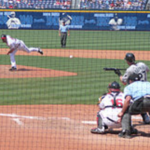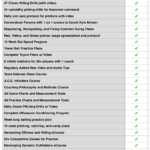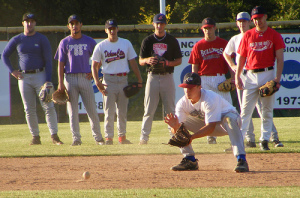Running an Effective Tryout
Another blast of arctic air (temps down to -10) is barreling down on the Chicago this week. To many of you that means hats and mittens, for me it means baseball season starts on Monday.
For those of you not from the north, this is, in fact, a common occurrence the week before tryouts. Many coaches in cold weather climates run into the same dilemma that I have; you need to assess your players and select your team without actually getting to play outside. I can count on one finger the number of times I have held a tryout outside in my ten years of coaching.
This is extremely challenging because I care much more what a player does in a game situation than what they look like hitting off a tee or how fast they run, and none of that looks like real baseball in a gym.
Unfortunately for me and them, we never get to scrimmage in our tryouts.
As I am preparing for our season, I am reminded that tryouts are a very bittersweet time of the year. It marks the beginning of baseball season, which is very exciting. But inevitably, it marks the end of someone’s baseball career, which is upsetting. The worst part about it is that I get to choose whose career effectively ends next week.
Measurement Tools for Indoor Tryouts
This task has not gotten any easier over the past decade, so in order to rationalize the large responsibility I have been granted, I have come up with a few rules for our staff during tryouts: 1.) Keep the maximum number of feasible players, 2.) ensure that the tryout is fair, equitable, and takes as many facets of the game into account as possible, and 3.) be objective and honest in the cut process.
Below are some methods for making tryouts as fair and equitable as possible:
1.) Allow players to make as many decisions as possible in tryouts
a.) Evaluate how they work/behave when nobody is directing them
b.) See how they will perform when they are on their own
2.) Give specific expectations ahead of time
a.) What intangible characteristics will you be looking at?
b.) What skills will you be looking for at each position?
c.) Share the evaluation tool with parents and players ahead of time
3.) Measure as many things as possible
a.) Measure speed, don’t guess who is faster
b.) Measure batting practice rounds
c.) Measure velocity (if you can)
d.) Measure strike and quality strike % for pitchers
4.) Decide what skills you want to emphasize ahead of time
a.) Will you value offense or defense more?
b.) How much will you emphasize speed?
c.) What type of team do you want to have?
d.) How many pitchers do you need for your season?
e.) How much do you value players who play multiple positions?
Making cuts
The actual method of making cuts is not a one size fits all process. Each coach needs to decide which method fits them and their community best. The three basic methods are face-to-face, posting a list, and player letters. Each has their advantages and disadvantages but as long as you are honest and unbiased, the process will go as painlessly as possible. Below is a list of keys to making the cut process as painless for yourself and the players you are cutting:
1.) Be honest
2.) Be gentle (don’t go on and on about why you are cutting them)
3.) Give useful feedback
4.) Encourage
5.) Keep ratings confidential (shared only with the parent and the player)
The cut process is not one that any coach looks forward to, but with a little planning the pain can be minimized for both your players and you.
Measurement Tools for Indoor Tryouts
More from my site
 CCA Podcast 206 – Getting your pitchers ready for opening day
CCA Podcast 206 – Getting your pitchers ready for opening day CCA Podcast 070: 10 tips for playing great team defense part 1
CCA Podcast 070: 10 tips for playing great team defense part 1 CCA Podcast 062: What do baseball players need to do in the weight room?
CCA Podcast 062: What do baseball players need to do in the weight room? December Month of Giving Library
December Month of Giving Library CCA Podcast 175 – Training vs. Coaching vs. Lesson approach
CCA Podcast 175 – Training vs. Coaching vs. Lesson approach Mini – Three tips for running great practices in a team setting
Mini – Three tips for running great practices in a team setting
 Posted by Kyle Nelson
Posted by Kyle Nelson- Posted in Uncategorized
 Feb, 24, 2014
Feb, 24, 2014 1 Comment.
1 Comment.
Elite members login here
Check out what’s New/Hot!
Recognizing, Diagnosing, and Fixing Common Hitting Flaws eCourse The 3 metrics we tested on Blast motion sensors this year Sneak Peek Inside an Elite Q and A The batting practice continuum Elite Member’s area table of contents 50+ “Chaos” hitting drills
5 sample Chaos hitting drills FREE
Mental Skills and Culture Building The hitting pyramid Welcome Elite Member, Trey! Ideas for a pitcher first practice 12 week bat speed improvement plan Make plans this offseason to have your team playing their best baseball at the end of the year” Top 5 hitting drills to translate practice skill to game performanceHow we used Blast Motion sensors with a team in 2019
What to do if your hitters are overmatched Welcome Elite Member, Tommy! Setting your baserunners up for success Welcome Elite Member, Mike! A consulting call with Elite Member Matt FREE Web Clinic: Developing Athletic, Consistent, Extraordinary Infielders
 Coach Kyle Nelson
Coach Kyle Nelson
“Evaluate how they work/behave when nobody is directing them”
I think that’s a great idea! Attitude is so important and so is intrinsic motivation. The best players aren’t always the show stoppers but rather the ones that are consistent, determined and have a good head on their shoulders. They keep at it even when they think no one is watching because they take pride in their own ability.